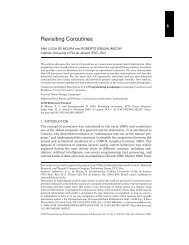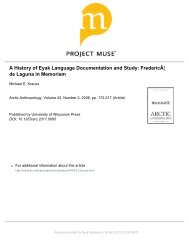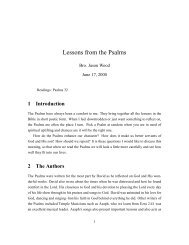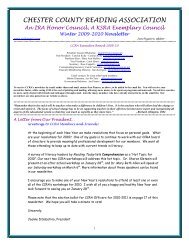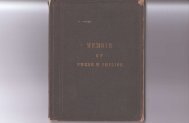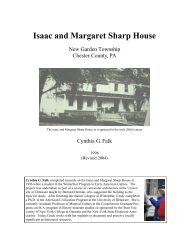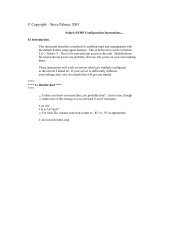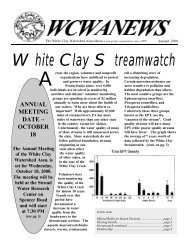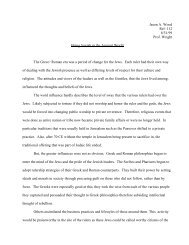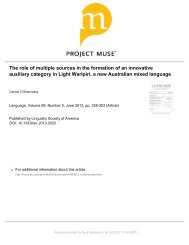Create successful ePaper yourself
Turn your PDF publications into a flip-book with our unique Google optimized e-Paper software.
a satisfactory device. He also attempted to symbolize<br />
durational differences by introducing characters of<br />
different widths. However, his system had no better<br />
success than did others of the time.<br />
Languages of America and Africa<br />
In the early 19th century, most of the languages<br />
of Africa and the indigenous languages of America<br />
had no writing systems. Pierre Duponceau (see<br />
Duponceau, Pierre Etienne (1760–1844)), a French<br />
émigré to the United States, won the Volney Prize in<br />
1838 with his Mémoire sur le système grammatical<br />
des langues de quelques nations indiennes de l’Amérique<br />
du Nord, and had shown in an earlier article<br />
(‘English phonology,’ 1817) a thorough understanding<br />
of the principles of a universal alphabet, though<br />
he never produced one himself. Under his influence,<br />
John Pickering (1777–1846), like Duponceau a lawyer<br />
by training, was led to publish his Essay on a<br />
uniform orthography for the Indian languages of<br />
North America (Cambridge, Massachusetts, 1818).<br />
Pickering, like Sir William Jones, whose work he<br />
admired, used a Roman alphabet supplemented by<br />
digraphs and some diacritics, preferring small superscript<br />
letters or subscript numerals to dots or hooks,<br />
which he felt might accidentally be omitted. This<br />
system was designed specifically for Native American<br />
languages, not as a universal alphabet.<br />
Many of the missionary societies were concerned<br />
at this time to establish a standard transcription system.<br />
The Church Missionary Society produced a<br />
pamphlet in 1848 entitled Rules for reducing unwritten<br />
languages to alphabetical writing in Roman characters:<br />
with reference especially to the languages<br />
spoken in Africa. The rules allowed some flexibility<br />
in deciding how detailed the transcription should be,<br />
according to its intended use. The notation suggested<br />
was Roman based, with a few diacritics and some<br />
digraphs. Lewis Grout produced a Roman-based system<br />
for Zulu in 1853, on behalf of the American<br />
Mission in Port Natal, using the symbols <br />
for the clicks.<br />
Carl Richard Lepsius (1810–1884)<br />
In 1852, the Church Missionary Society (CMS) invited<br />
the distinguished German Egyptologist Lepsius to<br />
adapt an alphabet that he had devised earlier, to suit<br />
the needs of the Society. Lepsius had been interested<br />
in writing systems for many years. In 1853, he won<br />
the agreement of the Royal Academy of Berlin to fund<br />
the cutting and casting of type letters for a new alphabet,<br />
to be used as a basis for recording languages with<br />
no writing system. In the following year, an Alphabetical<br />
Conference was convened in London, on the<br />
initiative of the Prussian ambassador in London, Carl<br />
<strong>Phonetic</strong> <strong>Transcription</strong>: <strong>History</strong> 403<br />
Bunsen, who, as a scholar with an interest in philology,<br />
wished to explore the possibility of an agreed<br />
system for representing all languages in writing. The<br />
conference was attended by representatives from the<br />
CMS, the Baptist Missionary Society, the Wesleyan<br />
Missionary Society, and the Asiatic and Ethnological<br />
Societies, and a number of distinguished scholars,<br />
including Lepsius and Friedrich Max Müller. In spite<br />
of their well-known involvement in the transcription<br />
problem, neither Isaac Pitman nor A. J. Ellis was<br />
among those included. Four resolutions were passed:<br />
(1) the new alphabet must have a physiological basis,<br />
(2) it must be limited to the ‘typical’ sounds employed<br />
in human speech, (3) the notation must be rational<br />
and consistent and suited to reading and printing and<br />
also it should be Roman based, supplemented by<br />
various additions, and (4) the resulting alphabet<br />
must form a standard ‘‘to which any other alphabet is<br />
to be referred and from which the distance of each<br />
is to be measured.’’<br />
Lepsius and Max Müller both submitted alphabets<br />
for consideration; Müller’s Missionary alphabet,<br />
which used italic type mixed with roman type, was<br />
not favored, and Lepsius’s extensive use of diacritics<br />
had obvious disadvantages for legibility and the availability<br />
of types. The conference put off a decision,<br />
but later in 1854, the CMS gave its full support to<br />
Lepsius’s alphabet. A German version of the alphabet<br />
appeared in 1854 (Das allgemeine linguistische Alphabet),<br />
followed in 1855 by the first English edition,<br />
entitled Standard alphabet for reducing unwritten<br />
languages and foreign graphic systems to a uniform<br />
orthography in European letters. The Lepsius<br />
alphabet had some success in the first few years, but<br />
Lepsius was pressed by the CMS to produce a new<br />
enlarged edition, which appeared in English in 1863<br />
(printed in Germany, like the first edition, because<br />
the types were only available there; see Figure 5).<br />
The most obvious difference from the first edition<br />
was that the collection of alphabets, illustrating the<br />
application of Lepsius’s standard alphabet to different<br />
languages, had been expanded from 19 pages and<br />
Figure 5 Symbols of the standard alphabet devised by Lepsius<br />
in 1863.



